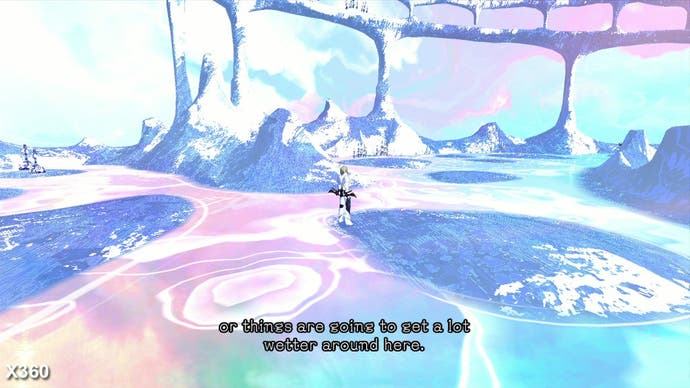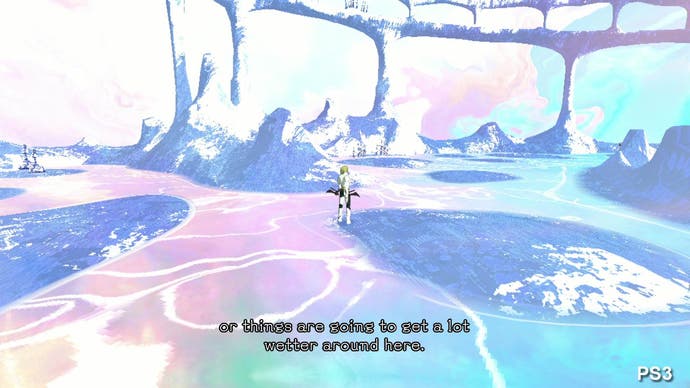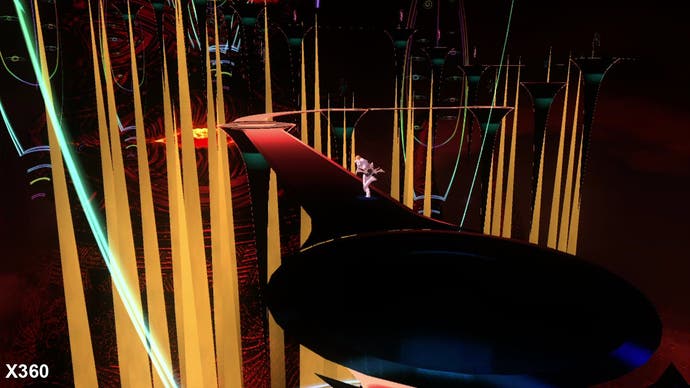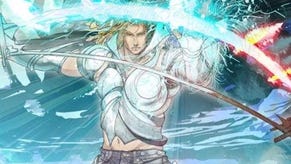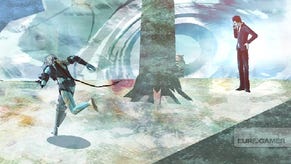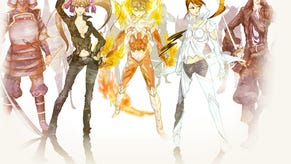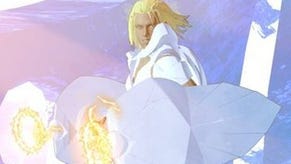Face-Off: El Shaddai: Ascension of the Metatron
Don't Enoch it.
| - | Xbox 360 | PlayStation 3 |
|---|---|---|
| Disc Size | 4.8GB | 7.3GB |
| Install | 4.8GB (optional) | 4524MB (mandatory) |
| Surround Support | Dolby Digital | Dolby Digital, 5.1LPCM |
Following on from his work on the Wii version of Okami, former Clover Studio art director Takeyasu Sawaki's latest action-platformer has been met with relatively little attention in the build-up to this busy quarter - perhaps unfairly so.
In much the same way Okami portrayed the journey of a Japanese deity through abstract splashes of a traditional Japanese watercolour palette, El Shaddai offers its own distinct marriage of narrative theme and art style. This time, the pairing involves characters and settings inspired by the Judeo-Christian universe put to lucid backdrops painted by an early Renaissance-style brush, with just a hint of Studio Ghibli's whimsy behind the character designs - so it's set to be quite the looker, then.
From a strictly aesthetic standpoint, the dull moments are few and far between. From the sparkling arctic wasteland to a monolithic tower surrounded by fireworks, there's an impressive visual variety to generate screens and video footage from for this analysis. And that's even before arriving at the chapter set aside for the demo, by which point you've been introduced to the more Japanese influences. Please do check out Keza MacDonald's Eurogamer El Shaddai review and "making of" feature for a more thorough inspection of this eclectic mix.
While the grand vision for El Shaddai is to be congratulated, it must be said that developer Ignition Tokyo's unwillingness to compromise does come at an evident technical cost - both in terms of image quality and performance. It's worth noting that the game is built on the latest "Lightspeed" version of the ubiquitous middleware engine, Gamebryo, well known for its use in Bethesda's RPG offerings this generation. This incarnation in particular was designed to cater for more speedy and efficient implementations of art assets, which no doubt suited the heavily art-driven development of the project.
With that said, although Gamebryo has fared admirably as a multi-platform tool in recent years, with games like Oblivion utilising the strengths of each console to their advantage, there is a notable disparity in image quality between the PS3 and 360 versions here. According to our tests, the PS3 runs at 1152x576, with no anti-aliasing to speak of whatsoever. To combat the resulting jaggies as best it can, a very light blur filter is in effect, although this only goes so far in hiding the prominent stair-stepping on some edges. It's a shame that no post-process anti-aliasing solution could have been applied in this case, as this blemish to the image quality does no justice to the art assets.
Meanwhile, the 360 offers an image that's noticeably easier on the eye. Weighing in it at a marginally lower 1120x576, the upscaling is veiled behind a lick of 2x multi-sample anti-aliasing (MSAA) that inevitably does a better job of quashing those sharp edges, as you can see in the following head-to-head movie, plus the accompanying El Shaddai comparison gallery.
But why 1120? The cause for this lower horizontal resolution is logical when considering the 10MB limitations of the 360's eDRAM. Using the same resolution as the PS3 in conjunction with 2x MSAA, a 32-bit pixel format and 32-bit z-buffer would have exceeded this limit by 1.25 per cent. By nipping and tucking that horizontal value down to 1120, Ignition Tokyo is able to comfortably use up the eDRAM, avoiding a scenario where costly tiling of the image becomes necessary and where the hardware anti-aliasing effectively becomes "free".
On top of this, the 360 seems to be running some form of edge filter, likely to clear up what the MSAA couldn't with the base sub-HD image. However, as with many post-processing techniques working indiscriminately with the whole frame, the edge filtering comes at the cost of additional blurring to subtitles and graphical overlays. It's fortunate, then, that the decision to take this route is largely mitigated by the game's policy of turning all HUD elements off during the first play-through, so it's by no means a deal-breaker. As for the more regular incidents of subtitling, it's only when you compare the PS3 and 360 side-by-side that you'd notice the difference in clarity.
The game's unique, kaleidoscopic visual style owes itself to an animation technique called texture substitution, whereby different textures are revealed exclusively through certain transparent surfaces in the geometry. For the most part, both consoles achieve parity: specular effects, bloom and lighting models are a match. However, the PS3 is let down somewhat by its use of lower resolution animated textures, with pixellation especially evident in the rippling effect in puddles during the Arctic sections, and the edges of the rolling clouds in a later platforming level.
